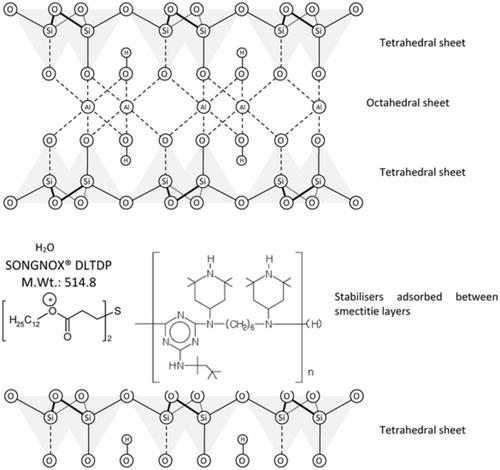当前位置:
X-MOL 学术
›
J. Vinyl Addit. Technol.
›
论文详情
Our official English website, www.x-mol.net, welcomes your
feedback! (Note: you will need to create a separate account there.)
High‐temperature stabilization of polypropylene using hindered phenol–thioester stabilizer combinations, Part 2: Optimization and efficacy via encapsulation with silicate fillers
Journal of Vinyl and Additive Technology ( IF 3.8 ) Pub Date : 2021-02-02 , DOI: 10.1002/vnl.21814 Norman S. Allen 1 , Andrew P. Jones 1 , Christopher M. Liauw 1 , Michele Edge 1 , Klaus Keck‐Antoine 2, 3 , Joeng‐Ho Yeo 2
Journal of Vinyl and Additive Technology ( IF 3.8 ) Pub Date : 2021-02-02 , DOI: 10.1002/vnl.21814 Norman S. Allen 1 , Andrew P. Jones 1 , Christopher M. Liauw 1 , Michele Edge 1 , Klaus Keck‐Antoine 2, 3 , Joeng‐Ho Yeo 2
Affiliation

|
The thermal degradation of unstabilized polypropylene has been investigated under long‐term thermal aging at 150°C, with additive concentration studies on combinations of an established hindered phenolic antioxidant (pentaerythritol tetrakis (3‐(3,5‐di‐tert‐butyl‐4‐hydroxyphenyl) propionate) [S1010] and two popular thioesters (distearyl‐3,3′‐thiodipropionate [DSTDP] and didodecyl‐3,3′‐thiodipropionate [DLTDP]) using melt flow rate (MFR), carbonyl index (Fourier transform spectroscopy [FTIR]) and differential scanning calorimetry (DSC) (oxidation induction time [OIT]) and ultimate embrittlement time (fracture) on injection‐molded test pieces. It was found in part 1 that 20:80 phenol:thioester ratios provided the best long‐term thermal stability (LTTS). Part 2 investigates potential improvements in stabilization, involving the use of controlled release systems in which the stabilizers are melt blended in the PP together with high surface area inorganic substrates. Here, a calcined gel silica SD3128 and two layered silicates Rockwood Additives Fulcat® 800 and Laponite® B were incorporated into the polymer formulations in order to limit stabilizer mobility at 6000 ppm through potential surface adsorption and subsequent controlled release. Additional hindered amine light stabilizers were also added as long‐term heat stabilizers and to act as displacing agents that promote controlled release via competitive adsorption on processing due to the strongly adsorbing amine functionalities. In some instances, the LTTS showed improvement. Flow micro calorimetry was used to investigate the stabilizer–substrate interactions. It was found that as a result of its small pore structure, Laponite B could only adsorb smaller molecules such as that of DLTDP while Fulcat® 800 was a more strongly adsorbing substrate with larger pores able to accommodate even the largest of the hindered amine light stabilizer (HALS) molecules. The gel silica SD3128 had overall the most adsorbing ability with each of these characteristics supporting the aging data studied in parallel. The data are discussed in relation to the long‐term stabilization of polypropylene in high‐temperature applications such as under the bonnet of automobiles where minimizing stabilizer losses and maximizing synergy are important.
中文翻译:

使用受阻酚-硫酯稳定剂组合物对聚丙烯进行高温稳定化,第2部分:通过硅酸盐填料包封的优化和功效
涉及使用控释系统,其中稳定剂与高表面积的无机底物一起熔融共混在PP中。此处,将煅烧的凝胶二氧化硅SD3128和两层硅酸盐Rockwood AdditivesFulcat®800和Laponite®B掺入到聚合物配方中,以通过潜在的表面吸附和随后的控制释放将稳定剂的流动性限制在6000 ppm。还添加了其他受阻胺光稳定剂作为长期的热稳定剂,并由于强吸附性胺官能团的作用,通过在加工过程中的竞争性吸附而促进了控制释放的置换剂。在某些情况下,LTTS有所改善。流动微量量热法用于研究稳定剂-底物的相互作用。已发现,由于其小孔结构,Laponite B只能吸附较小的分子,例如DLTDP,而Fulcat®800是吸附力更强的底物,具有更大的孔,甚至可以容纳最大的受阻胺光稳定剂。 (HALS)分子。凝胶二氧化硅SD3128总体上具有最大的吸附能力,这些特性中的每一个都支持并行研究的老化数据。讨论了有关聚丙烯在高温应用中的长期稳定性的数据,例如在汽车发动机罩下,其中稳定剂的损失最小化和协同作用的最大化是至关重要的。Laponite B只能吸附较小的分子,例如DLTDP,而Fulcat®800是具有更大孔隙的更强吸附基质,即使最大的受阻胺光稳定剂(HALS)分子也能容纳。凝胶二氧化硅SD3128总体上具有最大的吸附能力,这些特性中的每一个都支持并行研究的老化数据。讨论了有关聚丙烯在高温应用中的长期稳定性的数据,例如在汽车发动机罩下,其中稳定剂的损失最小化和协同作用的最大化是至关重要的。Laponite B只能吸附较小的分子,例如DLTDP,而Fulcat®800是具有更大孔隙的更强吸附基质,即使最大的受阻胺光稳定剂(HALS)分子也能容纳。凝胶二氧化硅SD3128总体上具有最大的吸附能力,这些特性中的每一个都支持并行研究的老化数据。讨论了有关聚丙烯在高温应用中的长期稳定性的数据,例如在汽车发动机罩下,其中稳定剂的损失最小化和协同作用的最大化是至关重要的。
更新日期:2021-02-02
中文翻译:

使用受阻酚-硫酯稳定剂组合物对聚丙烯进行高温稳定化,第2部分:通过硅酸盐填料包封的优化和功效
涉及使用控释系统,其中稳定剂与高表面积的无机底物一起熔融共混在PP中。此处,将煅烧的凝胶二氧化硅SD3128和两层硅酸盐Rockwood AdditivesFulcat®800和Laponite®B掺入到聚合物配方中,以通过潜在的表面吸附和随后的控制释放将稳定剂的流动性限制在6000 ppm。还添加了其他受阻胺光稳定剂作为长期的热稳定剂,并由于强吸附性胺官能团的作用,通过在加工过程中的竞争性吸附而促进了控制释放的置换剂。在某些情况下,LTTS有所改善。流动微量量热法用于研究稳定剂-底物的相互作用。已发现,由于其小孔结构,Laponite B只能吸附较小的分子,例如DLTDP,而Fulcat®800是吸附力更强的底物,具有更大的孔,甚至可以容纳最大的受阻胺光稳定剂。 (HALS)分子。凝胶二氧化硅SD3128总体上具有最大的吸附能力,这些特性中的每一个都支持并行研究的老化数据。讨论了有关聚丙烯在高温应用中的长期稳定性的数据,例如在汽车发动机罩下,其中稳定剂的损失最小化和协同作用的最大化是至关重要的。Laponite B只能吸附较小的分子,例如DLTDP,而Fulcat®800是具有更大孔隙的更强吸附基质,即使最大的受阻胺光稳定剂(HALS)分子也能容纳。凝胶二氧化硅SD3128总体上具有最大的吸附能力,这些特性中的每一个都支持并行研究的老化数据。讨论了有关聚丙烯在高温应用中的长期稳定性的数据,例如在汽车发动机罩下,其中稳定剂的损失最小化和协同作用的最大化是至关重要的。Laponite B只能吸附较小的分子,例如DLTDP,而Fulcat®800是具有更大孔隙的更强吸附基质,即使最大的受阻胺光稳定剂(HALS)分子也能容纳。凝胶二氧化硅SD3128总体上具有最大的吸附能力,这些特性中的每一个都支持并行研究的老化数据。讨论了有关聚丙烯在高温应用中的长期稳定性的数据,例如在汽车发动机罩下,其中稳定剂的损失最小化和协同作用的最大化是至关重要的。






























 京公网安备 11010802027423号
京公网安备 11010802027423号